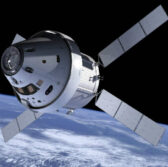 Lockheed Martin, NASA and the U.S. Navy have finished a second round of simulated ocean recoveries for the Orion spacecraft, which is scheduled for its first unmanned test flight in December.
Lockheed Martin, NASA and the U.S. Navy have finished a second round of simulated ocean recoveries for the Orion spacecraft, which is scheduled for its first unmanned test flight in December.
The team practiced different methods and tried new hardware for retrieving the spacecraft after it descends to the Pacific Ocean later this year, NASA said Wednesday.
“Completing recovery simulations in a real, ocean environment before Exploration Flight Test-1 is incredibly helpful,†said Larry Price, Lockheed’s Orion deputy program manager.
“This test allows us to improve the procedures for handling the crew module and determine if the recovery equipment designs are precise, safe and efficient,” Price added.
According to Lockheed, Navy divers worked to position and retrieve an Orion test article on the branch’s amphibious transport dock ship USS Anchorage by using a Lockheed-made cradle, sea anchor and winch.
The Orion trials occurred off the coast of San Clemente Island in Southern California.
“We were able to put Orion out to sea and safely bring it back multiple times,” said Mike Generale, NASA recovery operations manager for the Ground Systems Development and Operations Program.
“We are ready to move on to the next step of our testing with a full dress rehearsal landing simulation on the next test,” Generale added.
NASA says Orion would re-enter Earth’s atmosphere at a speed of almost 20,000 miles per hour and is built to withstand temperatures of up to 4,000 degrees Fahrenheit.




